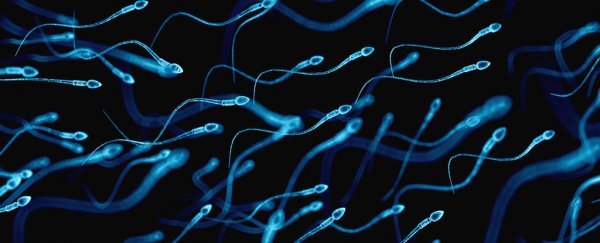The rhythmic back and forth motions that make up a sperm's swimming movement can be explained by a mathematical formula, according to new research.
Scientists analysed the beat of individual sperm tails (called flagella) to reconstruct their waveform mathematically. By understanding how individual sperm travel through fluid, the researchers say it will help us figure out how larger groups of sperm behave and interact – something that could be crucial for developing treatments for male infertility.
Researchers are able to study sperm movement thanks to the power of microscopic magnification, but the technique doesn't allow us to analyse sperm group behaviour – partly because there's just so many of the tiny sperm cells vying for a single egg.
"Around 55 million spermatozoa are found in a given sample, so it is understandably very difficult to model how they move simultaneously," explains mathematician Hermes Gadêlha from the University of York in the UK.
"We wanted to create a mathematical formula that would simplify how we address this problem and make it easier to predict how large numbers of sperm swim. This would help us understand why some sperm succeed and others fail."
 Kyoto University
Kyoto University
To capture the swimming motions, the team filmed a sample from a human sperm donor under the microscope at almost 300 frames per second.
This data was then fed into a computer, which analysed the beat of the sperm's tail and generated a waveform of the tiny cells' flagellar movements.
The team was then able to reconstruct the waveform mathematically, with a formula that recreates the beats and helps us understand how the sperm's swimming motion impacts the flow of fluid around it.
According to the researchers, sperm pushes itself forward with a contradictory, jerky movement that simultaneously pulls the head backwards and sideways.
"You would assume that the jerky movements of the sperm would have a very random impact on the fluid flow around it, making it even more difficult for competing sperm cells to navigate through it, but in fact you see well defined patterns forming in the fluid around the sperm," explains Gadêlha.
In particular, the whip-like motion of the flagellum that pulls the head backwards and sideways is able to counter some of the friction that sperm encounter as they swim through flowing fluid.
"This suggests that to achieve [locomotion], sperm stirs the fluid around in a very coordinated way… not too dissimilar to the way in which magnetic fields are formed around magnets," Gadêlha says.
"So although the fluid drag makes it very difficult for the sperm to make forward motion, it does coordinate with its rhythmic movements to ensure that only a few selected ones achieve forward propulsion."
Now that these movements have been recreated in a formula, the team says it will be easier to calculate how fluid flows can affect large groups of sperm, which could help scientists examine why some men's sperm don't swim strongly enough to fertilise an egg.
The next step for the researchers will be to do just that, applying their model to see how it goes at predicting the movement of larger numbers of sperm cells.
Depending on the results, we may discover insights that could help with developing treatments for male infertility problems – giving these tiny swimmers the little nudge they need to get where they're going.
"It is true when scientists say how miraculous it is that a sperm ever reaches an egg," says Gadêlha, "but the human body has a very sophisticated system of making sure the right cells come together."
The findings are to be published in an upcoming edition of Physical Review Letters.
